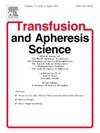Genotype pattern of factor V and XIII abnormalities in the Iranian population: A meta-analysis
IF 1.2
4区 医学
Q4 HEMATOLOGY
引用次数: 0
Abstract
Background
Hemostatic disorders are significantly associated with morbidity and mortality. Hence, the examination of coagulation abnormalities is a cornerstone of prevention and therapy. This meta-analysis aimed to determine the genotype pattern of Factor V (FV) and XIII (FXIII) abnormalities in the Iranian population. Methods The search strategy was conducted in electronic databases including Web of Science, PubMed, Scopus, SID, ProQuest, and Magiran, covering the period from May 10,1990, to May 10, 2019, following the PRISMA principles. Studies of various designs,including cross-sectional, cohort, experimental, and case-control studies, were included based on specific criteria, without any limitations on gender or language.Results Out of 10,449 research entries, 10,432 were screened, with 132 abstracts and titles analyzed, 23 full articles reviewed, and ultimately 11 studies included in the metaanalysis. The mutation c.1691 G>A: GG (95 % CI: 0.98) had the greatest occurrence rate in FV deficient patients, while the 34Val/Leu mutation (95 % CI: 1.00) was detected as the most prevalent mutation in instances of FXIII insufficiency. Conclusions Specific FV and XIII gene mutations are associated with increased risk for thrombotic conditions. FV deficiency with the c.1691 G>A mutation was prevalent in stroke patients, while FXIII deficiency with the 34Val/Leu mutation was linked to recurrent miscarriages.
伊朗人群中因子V和因子XIII异常的基因型模式:荟萃分析
背景:止血障碍与发病率和死亡率显著相关。因此,检查凝血异常是预防和治疗的基石。本荟萃分析旨在确定伊朗人群中因子V (FV)和因子XIII (FXIII)异常的基因型模式。方法在Web of Science、PubMed、Scopus、SID、ProQuest、Magiran等电子数据库中检索,检索时间为1990年5月10日至2019年5月10日,检索策略遵循PRISMA原则。各种设计的研究,包括横断面、队列、实验和病例对照研究,根据特定的标准纳入,没有性别或语言的限制。结果在10,449篇研究条目中,筛选了10,432篇,分析了132篇摘要和标题,审查了23篇全文,最终将11篇研究纳入元分析。突变c.1691 G>A: GG(95 % CI: 0.98)在FV缺陷患者中发生率最高,而34Val/Leu突变(95 % CI: 1.00)是FXIII功能不全患者中最常见的突变。结论:特异性FV和XIII基因突变与血栓形成风险增加有关。伴有c.1691 G>;A突变的FV缺陷在中风患者中普遍存在,而伴有34Val/Leu突变的FXIII缺陷与复发性流产有关。
本文章由计算机程序翻译,如有差异,请以英文原文为准。
求助全文
约1分钟内获得全文
求助全文
来源期刊
CiteScore
3.60
自引率
5.30%
发文量
181
审稿时长
42 days
期刊介绍:
Transfusion and Apheresis Science brings comprehensive and up-to-date information to physicians and health care professionals involved in the rapidly changing fields of transfusion medicine, hemostasis and apheresis. The journal presents original articles relating to scientific and clinical studies in the areas of immunohematology, transfusion practice, bleeding and thrombotic disorders and both therapeutic and donor apheresis including hematopoietic stem cells. Topics covered include the collection and processing of blood, compatibility testing and guidelines for the use of blood products, as well as screening for and transmission of blood-borne diseases. All areas of apheresis - therapeutic and collection - are also addressed. We would like to specifically encourage allied health professionals in this area to submit manuscripts that relate to improved patient and donor care, technical aspects and educational issues.
Transfusion and Apheresis Science features a "Theme" section which includes, in each issue, a group of papers designed to review a specific topic of current importance in transfusion and hemostasis for the discussion of topical issues specific to apheresis and focuses on the operators'' viewpoint. Another section is "What''s Happening" which provides informal reporting of activities in the field. In addition, brief case reports and Letters to the Editor, as well as reviews of meetings and events of general interest, and a listing of recent patents make the journal a complete source of information for practitioners of transfusion, hemostasis and apheresis science. Immediate dissemination of important information is ensured by the commitment of Transfusion and Apheresis Science to rapid publication of both symposia and submitted papers.

 求助内容:
求助内容: 应助结果提醒方式:
应助结果提醒方式:


